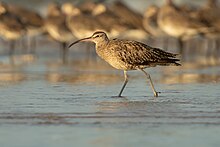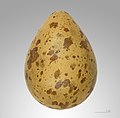Eurasian whimbrel
| Eurasian whimbrel | |
|---|---|

| |
| N. p. phaeopus | |

| |
| N. p. variegatus | |
| Scientific classification | |
| Kingdom: | Animalia |
| Phylum: | Chordata |
| Class: | Aves |
| Order: | Charadriiformes |
| Family: | Scolopacidae |
| Genus: | Numenius |
| Species: | N. phaeopus
|
| Binomial name | |
| Numenius phaeopus | |

| |
| Eurasian whimbrel range Breeding Migration Non-breeding
| |
| Synonyms | |
| |
The Eurasian whimbrel (Numenius phaeopus) is a wader in the large family Scolopacidae. It is one of the most widespread of the curlews, breeding across much of subarctic Asia and Europe as far south as Scotland. This species and the Hudsonian whimbrel have recently been split, although some taxonomic authorities still consider them to be conspecific.
Taxonomy[]
The Eurasian whimbrel was formally described by the Swedish naturalist Carl Linnaeus in 1758 in the tenth edition of his Systema Naturae under the binomial name Scolopax phaeopus.[2] It is now placed with the curlews in the genus Numenius that was introduced by the French ornithologist Mathurin Jacques Brisson in 1760.[3][4] The genus name Numenius is from Ancient Greek noumenios, a bird mentioned by Hesychius. It is associated with the curlews because it appears to be derived from neos, "new" and mene "moon", referring to the crescent-shaped bill. The specific epithet phaeopus is the Medieval Latin name for the bird, from Ancient Greek phaios, "dusky" and pous, "foot".[5] The English name "whimbrel" is imitative of the bird's call.[6]
Five subspecies are recognised:[4]
- N. p. islandicus Brehm, C.L., 1831 – breeds mainly in Iceland, but also in Greenland, Faroe Islands, and Scotland; winters mainly in West Africa, but ranges from southwestern Europe to Benin and Togo[7][8][9]
- N. p. phaeopus (Linnaeus, 1758) – nominate, breeds from Norway to north central Siberia; winters in Africa and south and southeast Asia
- N. p. alboaxillaris Lowe, 1921 – breeds from western Kazakhstan to southwestern Siberia (rare, endangered); winters in south and east Asia
- N. p. rogachevae Tomkovich, 2008 – breeds in north central Siberia; winters in east Afica and west India
- N. p. variegatus (Scopoli, 1786) – breeds in northeastern Siberia; winters in India to Australia
The Hudsonian whimbrel (Numenius hudsonicus) was formerly considered to be conspecific. The two species were split based on genetic and plumage differences.[4][10]
Description[]
Eurasian whimbrel is a fairly large wader though mid-sized as a member of the curlew genus. It is 37–47 cm (15–19 in) in length, 75–90 cm (30–35 in) in wingspan, and 270–493 g (9.5–17.4 oz; 0.595–1.087 lb) in weight.[11] It is mainly greyish brown, with a white back and rump (subspecies N. p. phaeopus and N. p. alboaxillaris only), and a long curved bill (longest in the adult female) with a kink rather than a smooth curve. It is generally wary.
The usual call is a rippling whistle, prolonged into a trill for the song.
The only similar common species over most of this bird's range are larger curlews. The whimbrel is smaller, has a shorter, decurved bill and has a central crown stripe and strong supercilia.
Distribution and migration[]
The Eurasian whimbrel is a migratory bird wintering on coasts in Africa, and South Asia into Australasia.[1] It is also a coastal bird during migration.[12] It is fairly gregarious outside the breeding season. It is found in Ireland and the United Kingdom, and it breeds in Scotland, particularly around Shetland, Orkney, the Outer Hebrides as well as the mainland at Sutherland and Caithness.
Behaviour and ecology[]
Breeding[]
The nest is a bare scrape on tundra or Arctic moorland. Three to five eggs are laid. Adults are very defensive of nesting area and will even attack humans who come too close.
Food and feeding[]
This species feeds by probing soft mud for small invertebrates and by picking small crabs and similar prey off the surface. Before migration, berries become an important part of their diet. It has also been observed taking insects, specifically blue tiger butterflies.[13]
Status[]
Near the end of the 19th century, hunting on their migration routes took a heavy toll on this bird's numbers; the population has since recovered. The whimbrel is one of the species to which the Agreement on the Conservation of African-Eurasian Migratory Waterbirds (AEWA) applies.[14]
Gallery[]

Egg of whimbrel - MHNT

Numenius phaeopus, on migration, Fuerteventura

ID composite

Whimbrel stamp of the Faroe Islands

Eurasian Whimbrel at Chilika Lake, India

N. p. islandicus
São Tomé and Príncipe
References[]
- ^ a b BirdLife International (2016). "Numenius phaeopus". IUCN Red List of Threatened Species. 2016: e.T22693178A86585436. doi:10.2305/IUCN.UK.2016-3.RLTS.T22693178A86585436.en. Retrieved 19 November 2021.
- ^ Linnaeus, Carl (1758). Systema Naturae per regna tria naturae, secundum classes, ordines, genera, species, cum characteribus, differentiis, synonymis, locis (in Latin). Volume 1 (10th ed.). Holmiae (Stockholm): Laurentii Salvii. p. 146.
|volume=has extra text (help) - ^ Brisson, Mathurin Jacques (1760). Ornithologie, ou, Méthode contenant la division des oiseaux en ordres, sections, genres, especes & leurs variétés (in French and Latin). Volume 1. Paris: Jean-Baptiste Bauche. Vol. 1, p. 48, Vol. 5, p. 311.
|volume=has extra text (help) - ^ a b c Gill, Frank; Donsker, David; Rasmussen, Pamela, eds. (July 2021). "Sandpipers, snipes, coursers". IOC World Bird List Version 11.2. International Ornithologists' Union. Retrieved 22 November 2021.
- ^ Jobling, James A (2010). The Helm Dictionary of Scientific Bird Names. London: Christopher Helm. pp. 276, 301. ISBN 978-1-4081-2501-4.
- ^ "Whimbrel". Oxford English Dictionary (Online ed.). Oxford University Press. (Subscription or participating institution membership required.)
- ^ Gunnarsson, T. G.; Guðmundsson, G. A. (2016). "Migration and non-breeding distribution of Icelandic Whimbrels Numenius phaeopus islandicus as revealed by ringing recoveries". Wader Study. 123 (1): 44–48. doi:10.18194/ws.00031.
- ^ Alves, J. A.; Dias, M. P.; Méndez, V.; Katrínardóttir, B.; Gunnarsson, T. G. (2016). "Very rapid long-distance sea crossing by a migratory bird". Scientific Reports. 6 (1): 38154. Bibcode:2016NatSR...638154A. doi:10.1038/srep38154. PMC 5128861. PMID 27901077.
- ^ Carneiro, C.; Gunnarsson, T. G.; Alves, J. A. (2019). "Faster migration in autumn than in spring: seasonal migration patterns and non-breeding distribution of Icelandic whimbrels". Journal of Avian Biology. 50 (1). doi:10.1111/jav.01938.
- ^ Tan, H.Z.; Ng, E.Y.X.; Tang, Q.; Allport, G.A.; Jansen, J.J.F.J.; Tomkovich, P.S.; Rheindt, F.E. (2019). "Population genomics of two congeneric Palaearctic shorebirds reveals differential impacts of Quaternary climate oscillations across habitats types". Scientific Reports. 9 (1): 18172. doi:10.1038/s41598-019-54715-9.
- ^ "Whimbrel". All About Birds. Cornell Lab of Ornithology.
- ^ Birds. Collins Pocket Guide. 1998. p. 156.
- ^ Woodall, P.F. (1996). "Whimbrel feeding on Blue Tiger butterflies". Sunbird. Queensland Ornithological Society. 26 (2): 46–48. ISSN 1037-258X.
- ^ "Species". Agreement on the Conservation of African-Eurasian Migratory Waterbirds (AEWA). Retrieved 14 November 2021.
External links[]
| Look up eurasian whimbrel in Wiktionary, the free dictionary. |
| Wikimedia Commons has media related to Numenius phaeopus. |
| Wikispecies has information related to Numenius phaeopus. |
- Whimbrel Species Account – Cornell Lab of Ornithology
- Whimbrel – Species text in The Atlas of Southern African Birds.
- Whimbrel – Numenius phaeopus – USGS Patuxent Bird Identification InfoCenter
- Whimbrel Migration Studies – The Center for Conservation Biology, College of William and Mary & Virginia Commonwealth University
- Numenius phaeopus in Field Guide: Birds of the World on Flickr
- RSPB Birds by Name: Whimbrel
- "Whimbrel media". Internet Bird Collection.
- Eurasian whimbrel photo gallery at VIREO (Drexel University)
- Interactive range map of Numenius phaeopus at IUCN Red List maps
- Audio recordings of Whimbrel on Xeno-canto.
- IUCN Red List least concern species
- Numenius (bird)
- Birds of Eurasia
- Birds described in 1758
- Taxa named by Carl Linnaeus







